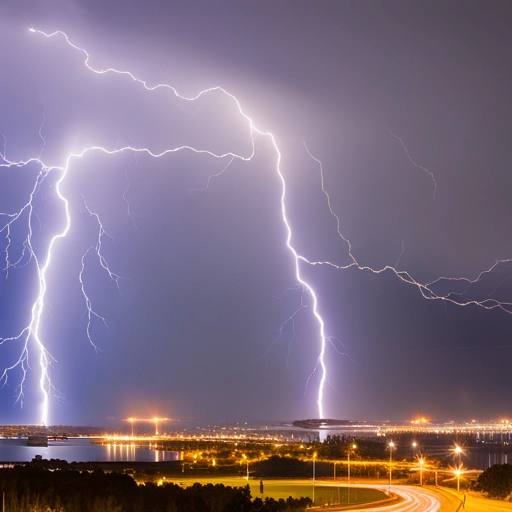As of my last knowledge update in September 2021, I can provide you with a general overview of lightning protection systems and their state-of-the-art technologies up to that point. Keep in mind that there might have been further advancements and developments in this field since then.
Introduction to Lightning Protection Systems: Lightning protection systems are designed to mitigate the damage caused by lightning strikes to structures and their occupants. Lightning is a discharge of static electricity that occurs due to the imbalance between positively and negatively charged particles in the atmosphere. When lightning strikes a building or other structures, it can cause fires, structural damage, and pose significant risks to human safety. Lightning protection systems aim to provide a controlled path for the lightning’s energy to safely dissipate into the ground, thereby minimizing potential harm.
Components of Lightning Protection Systems: A typical lightning protection system consists of the following components:
Air Terminals (Lightning Rods): These are elevated metal rods installed on the highest points of a structure. Their purpose is to intercept the lightning strike and provide a preferred path for the lightning to follow.
Conductors: Metal cables or strips that connect the air terminals to other components of the system and channel the lightning’s energy downward.
Grounding System: A network of conductive materials (such as copper or aluminum) buried in the ground. This system provides a low-resistance path for the lightning’s energy to dissipate harmlessly into the Earth.
Bonding: Ensuring all metal components of a structure, including pipes, vents, and equipment, are interconnected to prevent potential differences and reduce the risk of side flashes.
Surge Protection Devices: These devices are installed at critical points in the electrical system to divert transient voltage spikes caused by lightning away from sensitive equipment and appliances.
State-of-the-Art Developments: As of 2021, several advancements had been made in lightning protection systems:
Advanced Materials: Researchers have been exploring new materials with enhanced conductive properties and resistance to corrosion, which can improve the durability and effectiveness of lightning protection components.
Early Detection and Warning Systems: Modern lightning protection systems may include advanced sensors and monitoring equipment that detect the buildup of static charge in the atmosphere, providing early warnings to initiate protective measures.
Lightning Simulation and Modeling: Computer simulations and modeling techniques have become more sophisticated, allowing engineers to better understand lightning behavior and optimize the design of protection systems for specific structures.
Integration with Smart Building Systems: Lightning protection systems can be integrated with building automation and control systems, allowing for real-time monitoring, remote diagnostics, and maintenance.
Research into Lightning Behavior: Ongoing research into the physics of lightning and its interaction with structures has led to a deeper understanding of lightning’s mechanisms, enabling more effective protection strategies.
Lightning-Resistant Materials: The development of materials that can withstand lightning strikes without igniting or sustaining damage is an ongoing area of research.
Advanced Surge Protection: Surge protection devices have seen improvements in terms of their response time, clamping voltage levels, and ability to handle high-energy surges.
It’s important to note that the field of lightning protection is continuously evolving, driven by advancements in materials science, electronics, and engineering practices. To get the most up-to-date information on the state of the art in lightning protection systems, I recommend consulting recent research articles, industry publications, and experts in the field.
Lightning Protection Systems: A State-of-the-Art Review
Lightning is a natural phenomenon that can cause significant damage to structures and pose a threat to human safety. As a result, the development and implementation of effective lightning protection systems have become crucial. This article aims to provide a state-of-the-art review of lightning protection systems, focusing on their design, installation, and effectiveness.
Designing a lightning protection system involves considering various factors, such as the structure’s height, location, and materials used. The system typically consists of lightning rods, conductors, and grounding systems. Lightning rods, also known as air terminals, are strategically placed on the structure to intercept lightning strikes. Conductors, usually made of copper or aluminum, are used to carry the electrical current safely to the grounding system. The grounding system disperses the electrical energy into the ground, minimizing the risk of damage.
Installation of a lightning protection system requires expertise and adherence to industry standards and regulations. It is essential to ensure proper installation to maximize the system’s effectiveness. This includes correctly positioning the lightning rods, using appropriate conductors, and establishing a robust grounding system. Regular inspections and maintenance are also necessary to identify any potential issues and ensure the system’s continued functionality.
The effectiveness of a lightning protection system is evaluated based on its ability to prevent damage and protect the structure and its occupants. Various factors can influence the system’s effectiveness, such as the intensity and frequency of lightning strikes in the area, the design and installation quality, and the maintenance practices. Studies have shown that properly designed and installed lightning protection systems can significantly reduce the risk of lightning-related damage and injuries.
In conclusion, lightning protection systems play a vital role in safeguarding structures and individuals from the destructive forces of lightning. Designing and installing an effective system requires careful consideration of various factors, and adherence to industry standards is crucial. Regular inspections and maintenance are necessary to ensure the system’s continued functionality. By implementing state-of-the-art lightning protection systems, the risk of lightning-related damage can be significantly mitigated.



